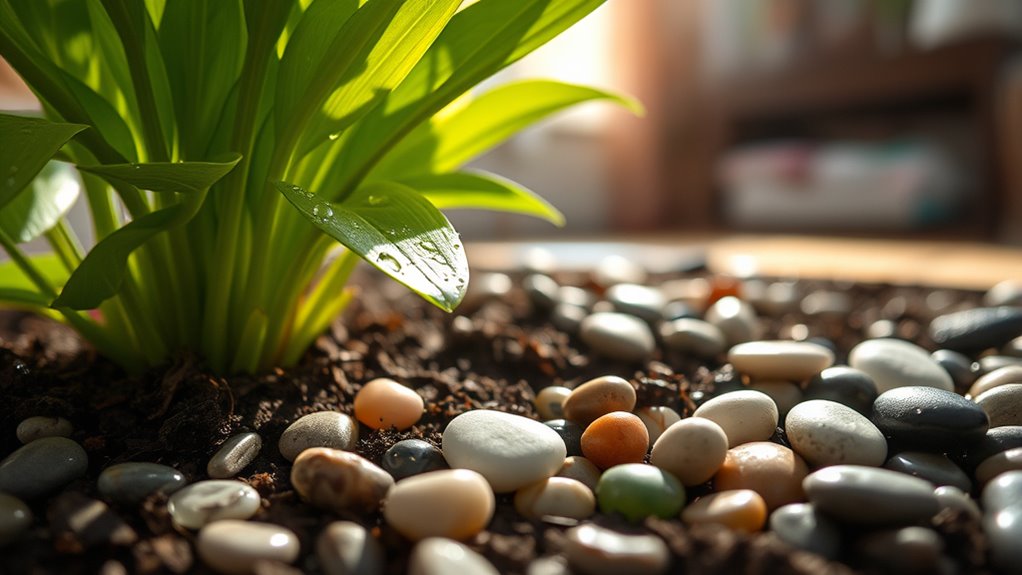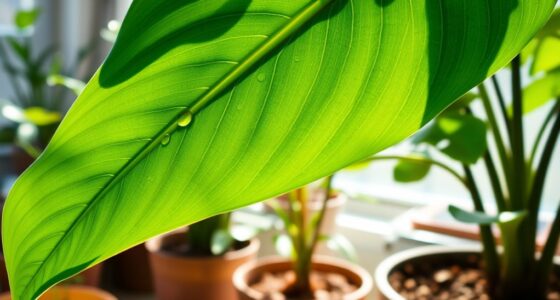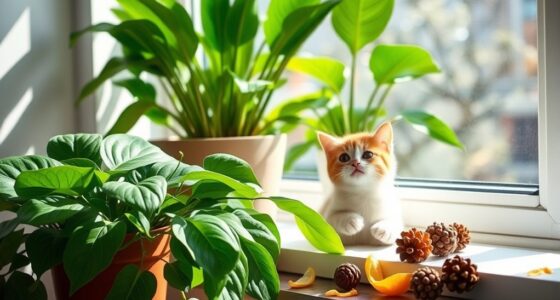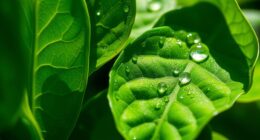Yes, you should put pebbles on top of your indoor plants’ soil. They enhance the aesthetic appeal while minimizing water evaporation and maintaining moisture levels. Pebbles also improve drainage, prevent soil erosion, and help deter pests. Just be sure to adjust your watering schedule since pebbles can slow down evaporation. If you want to learn more about the best types of pebbles to use and how to care for your pebbled plants, keep exploring!
Key Takeaways
- Pebbles enhance the aesthetic appeal of indoor plants, adding color and texture to your plant displays.
- They help minimize water evaporation, aiding in water conservation for your plants.
- A pebble layer maintains consistent soil moisture, which is beneficial for plant health.
- Pebbles improve drainage, preventing waterlogging and root rot in moisture-sensitive plants.
- Using pebbles can deter pests and suppress weeds, enhancing overall plant health.
Benefits of Using Pebbles on Indoor Plants

When you choose to use pebbles on top of the soil for your indoor plants, you’re not just adding a decorative touch; you’re also reaping several practical benefits.
First, pebbles enhance the aesthetic appeal of your plants, allowing for customization with various colors and textures that match your decor. They create unique displays and contribute to a serene ambiance. Additionally, pebbles can also help with water conservation by minimizing water evaporation, helping maintain consistent soil moisture and promoting plant health. This is particularly important for indoor plants, as proper moisture levels are crucial for their growth. Incorporating pebbles can also improve drainage by allowing excess water to escape, which is vital for preventing overwatering.
Pebbles add a stylish touch to your plants, offering color and texture that enhance your decor and create a tranquil atmosphere.
Furthermore, they deter pests, prevent soil erosion, and suppress weeds, protecting your plants. They also help increasing aeration by allowing better air access to the roots, which supports healthy growth. Lastly, pebbles improve drainage and aeration, preventing root rot and supporting healthy root systems.
Methods for Applying Pebbles
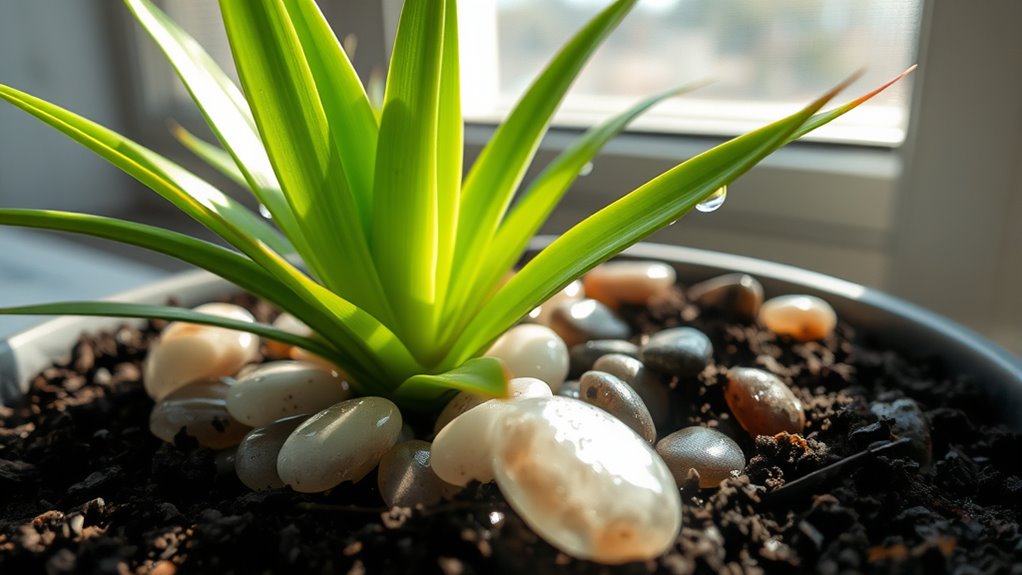
There are several effective methods for applying pebbles to enhance your indoor plants. One popular approach is using pebbles in propagation vessels, where they provide support for roots growing in water and prevent damage to fragile glassware. This technique is particularly suitable for plants like avocado seedlings, as it improves their growth environment. Additionally, studies suggest a correlation between astrological signs and perceived beauty, which can influence how you curate your indoor space.
You can also create humidity trays filled with pebbles to increase moisture around humidity-loving plants, preventing them from sitting in standing water. This is especially important for tropical plants, as they typically require higher humidity levels to thrive. Furthermore, incorporating natural materials like pebbles can enhance the overall aesthetic of your workspace, promoting a sense of tranquility and well-being.
Additionally, using pebbles for plant support helps keep stems upright and deters pets from digging in the soil. Each method not only benefits your plants but also adds an aesthetic touch to your indoor garden.
Types of Materials for Top Dressing
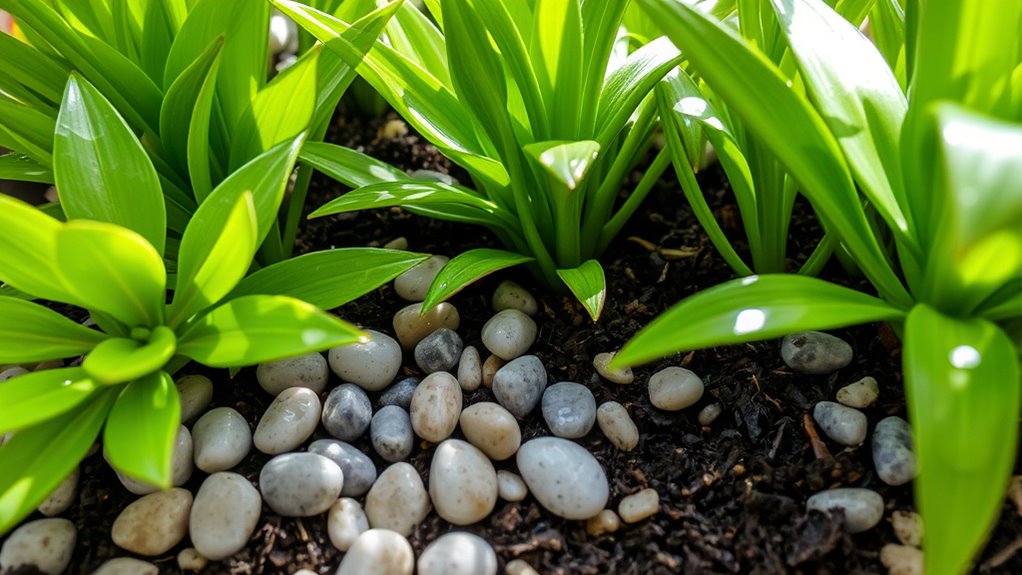
Applying pebbles and other materials on top of soil can significantly enhance both the health of your indoor plants and the overall aesthetic of your space. You can choose from various materials like river rock, which offers excellent drainage and visual appeal. Crushed glass provides colorful options for decoration, while moss retains moisture and comes in different hues. Additionally, topdressing materials can impact odors, allergens, pests, and fire safety indoors. Hardwood mulch is fire-code compliant, ensuring safety indoors. Eco-friendly poly-pebbles serve as a cost-effective alternative to natural stones. Additionally, crushed charcoal improves drainage and prevents root rot. Using the right materials can also reduce exposure to harmful airborne pollutants in your indoor environment. Choosing the right contrast ratios for your indoor plants can also affect their growth and overall health. It is essential to consider HEPA filter vacuums for maintaining clean air indoors, especially in spaces with plants that might attract dust and allergens. Consider your plant’s specific needs when selecting materials, as some might require moisture retention, while others benefit from excellent drainage. Each choice contributes to both plant health and design.
Plant Selection for Pebble Usage

Wondering how to choose the right plants for using pebbles? Start by considering humidity requirements.
Plants like ferns and orchids thrive in humid conditions and benefit from pebble usage. If you’re working with moisture-sensitive plants like swamp milkweed, pebbles help maintain consistent moisture levels. Additionally, using a pebble tray can enhance humidity naturally for these plants, mimicking their preferred environments. This is particularly important as timely storytelling can be crucial in creating a nurturing environment for your plants. Furthermore, understanding water requirements for different plant types can help in selecting the best candidates for pebble usage.
For temperature-sensitive varieties, pebbles can regulate soil temperature effectively. Also, think about drainage needs; orchids require excellent drainage that pebbles provide.
Aesthetically, pebbles enhance the visual appeal of delicate foliage, such as maidenhair ferns. You might also explore native plants like trillium or wild ginger, as they flourish in pebble-augmented environments.
Lastly, tropical plants, including bromeliads and anthuriums, thrive in humid conditions, making them perfect candidates for pebble usage.
Maintenance and Care for Pebbled Plants
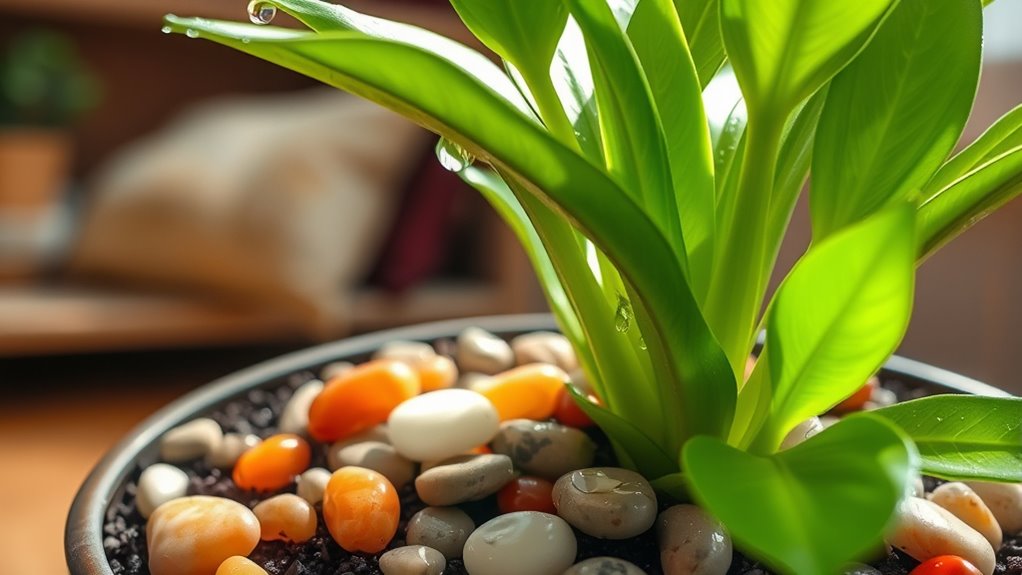
To keep your pebbled plants thriving, regular maintenance is essential. Start by adjusting your watering schedule; pebbles can reduce evaporation, meaning you may need to water less frequently. Always check soil moisture levels to prevent overwatering, as the pebbles can mask the soil’s condition. Living stones, or Lithops spp., thrive in sandy soil with excellent drainage, making it important to ensure your potting mix is suitable. Additionally, understanding cognitive decline in plants due to overwatering can help you maintain their health. Air-purifying qualities of certain plants can be enhanced by proper care and attention. Furthermore, like humans, plants also respond to high vibrational energy which can be cultivated through your positive interactions with them.
Periodically clean the pebbles to avoid debris buildup, which can hinder their effectiveness. Ensure the pebble layer isn’t too deep, as this might restrict your plant’s growth. Additionally, provide adequate soil aeration to prevent root suffocation. Be mindful of overheating in direct sunlight, and keep an eye out for waterlogging if drainage is poor. Lastly, ensure your soil is nutrient-rich, as pebbles won’t provide any nutrients for your plants.
Frequently Asked Questions
Can Pebbles Affect the Ph of the Soil?
Pebbles generally don’t affect the pH of the soil. Since they’re mostly made from natural materials, they’re pH-neutral.
If you’re worried about soil acidity or alkalinity, focus on other amendments instead. Using pebbles mainly helps with drainage and moisture retention, promoting healthier root growth.
How Thick Should the Pebble Layer Be?
When considering the thickness of a pebble layer, aim for about 1-2 pebbles thick.
This thickness effectively covers the soil while allowing your plant to thrive. You want it to look nice without overwhelming the plant or blocking water drainage.
A thinner layer helps with watering and ensures the pebbles don’t weigh down the pot.
Keep aesthetics in mind, too—arranging them nicely can enhance your plant’s appearance!
Are Colored Pebbles Safe for Plants?
Are colored pebbles safe for your plants?
Generally, they’re made from materials that are considered safe, and there’s no known toxicity associated with them.
However, some anecdotal reports suggest potential issues with dyes leaching into the soil.
It’s a good idea to test them in a small area first.
If you notice any negative effects, you might want to reconsider using them in your plant care routine.
Can I Reuse Pebbles From Other Plants?
Yes, you can definitely reuse pebbles from other plants! Just make sure to clean them thoroughly first.
Dry the pebbles, then soak them in a mild bleach solution to disinfect. Look out for any impurities, like white deposits, and discard those.
Once cleaned, you can store them for future use. Reusing pebbles not only saves money but also helps reduce waste while benefiting your indoor plants with improved aesthetics and moisture retention.
Do Pebbles Help With Drainage Issues?
Pebbles can help with drainage issues in some situations, but they’re not a foolproof solution.
If you place them at the bottom of your pot, they might keep soil from washing out, but over time, soil compaction can negate any benefits.
While pebbles can improve aeration and reduce evaporation when used on top, ensure your pots have proper drainage holes to maintain effective water flow for your plants.
Conclusion
Using pebbles on top of your indoor plants isn’t just a decorative choice; it can actually enhance soil drainage and prevent pests. Many believe that a layer of pebbles helps retain moisture without suffocating roots, making it a smart move for plant health. So, if you want to boost your plant care game, consider adding pebbles. You’ll not only elevate the look of your plants but also create a thriving environment for them to flourish.

